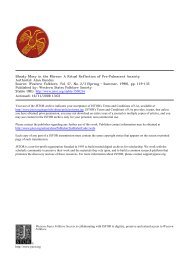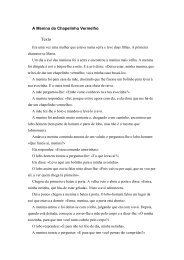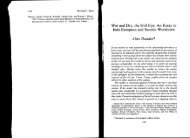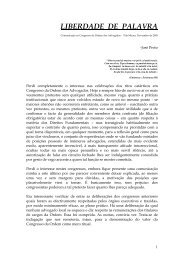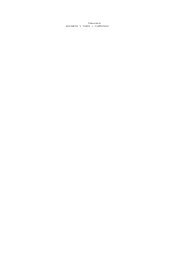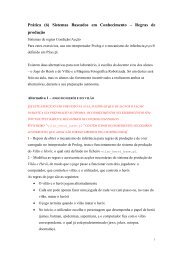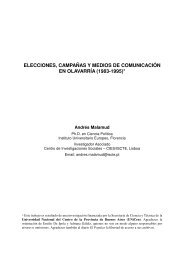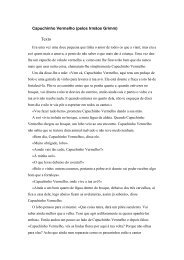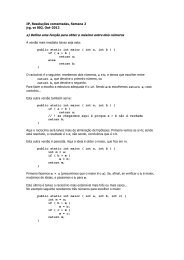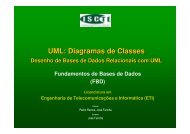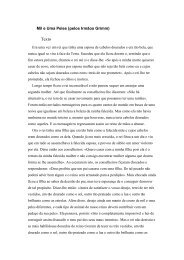Caderno 1 : Domínios de Definição, Limites e Continuidade
Caderno 1 : Domínios de Definição, Limites e Continuidade
Caderno 1 : Domínios de Definição, Limites e Continuidade
You also want an ePaper? Increase the reach of your titles
YUMPU automatically turns print PDFs into web optimized ePapers that Google loves.
Instituto Superior <strong>de</strong> Ciências do Trabalho e Empresa<br />
Curso: Gestão e GEI, 1 o Ano<br />
Ca<strong>de</strong>ira: Optimização<br />
<strong>Ca<strong>de</strong>rno</strong> 1 : <strong>Domínios</strong> <strong>de</strong> <strong>Definição</strong>, <strong>Limites</strong> e Continuida<strong>de</strong><br />
(Tópicos <strong>de</strong> teoria e exercícios)<br />
Elaborado por: Diana Al<strong>de</strong>a Men<strong>de</strong>s<br />
Departamento <strong>de</strong> Métodos Quantitativos<br />
Fevereiro <strong>de</strong> 2009
Capítulo 1<br />
Noções Topológicas e <strong>Domínios</strong> <strong>de</strong><br />
<strong>Definição</strong> <strong>de</strong> Funções<br />
1.1 Tópicos <strong>de</strong> Teoria<br />
<strong>Definição</strong> 1: Seja (R n ,d) um espaço métrico com a distância d entre dois pontos x =<br />
(x1,...,xn) ∈ Rn e y =(y1,...,yn) ∈ Rn <strong>de</strong>finida por:<br />
q<br />
d (x, y) = (x1 − y1) 2 + ...+(xn − yn) 2 .<br />
Seja a =(a1,...,an) ∈ R n e ε>0. A bola aberta <strong>de</strong> centro a eraioε <strong>de</strong>signa-se por<br />
B (a, ) ou B (a) eé<strong>de</strong>finida pelo seguinte conjunto <strong>de</strong> pontos<br />
0 a<br />
A A<br />
a-ε a+ε<br />
Bola aberta em R<br />
R<br />
B (a, ε) ={x ∈ R n : d (x, a)
2CAPÍTULO 1. NOÇÕES TOPOLÓGICAS E DOMÍNIOS DE DEFINIÇÃO DE FUNÇÕES<br />
por:<br />
• a éumponto interior <strong>de</strong> A se existe pelo menos uma bola aberta <strong>de</strong> centro a eraio<br />
ε contida em A, istoé<br />
∃ ε>0 tal que B (a, ) ⊆ A<br />
• a éumponto exterior <strong>de</strong> A se existe pelo menos uma bola aberta <strong>de</strong> centro a eraio<br />
ε contida em R n \A (ou seja: existe pelo menos uma bola aberta <strong>de</strong> centro a eraio<br />
ε que não contém pontos pertencentes a A), isto é<br />
∃ ε>0 tal que B (a, ) ⊆ R n \A ou seja B (a, ) ∩ A = ∅<br />
• a éumponto fronteiro <strong>de</strong> A se em qualquer bola aberta <strong>de</strong> centro a eraioε existe<br />
pelo menos um ponto <strong>de</strong> A eexistepelomenosumponto<strong>de</strong>R n \A, istoé<br />
∀ ε>0 : B (a, ) ∩ A 6= ∅ e B (a, ) ∩ R n \A 6= ∅<br />
• a éumponto <strong>de</strong> acumulação <strong>de</strong> A se em qualquer bola aberta <strong>de</strong> centro a eraioε<br />
existem infinitos elementos <strong>de</strong> A, istoé<br />
∀ ε>0 : B (a, ) ∩ Aé umconjuntoinfinito<br />
• a éumponto isolado se não é um ponto <strong>de</strong> acumulação.<br />
y<br />
exterior<br />
h−<br />
fronteiro<br />
h−<br />
interior<br />
exterior<br />
h−<br />
A<br />
h−<br />
h−<br />
1<br />
fronteiro<br />
y = 2<br />
isolado<br />
h−<br />
0 2<br />
x<br />
<strong>Definição</strong> 3: Seja (R n ,d) um espaço métrico com a distância d e A ⊆ R n . Designa-se<br />
• Interior <strong>de</strong> A (IntA) oconjuntodospontosinteriores<strong>de</strong>A
1.1. TÓPICOS DE TEORIA 3<br />
• Exterior <strong>de</strong> A (ExtA) o conjunto dos pontos exteriores <strong>de</strong> A<br />
• Fronteira <strong>de</strong> A (FrontA) o conjunto dos pontos fronteiros <strong>de</strong> A<br />
• Fecho ou a<strong>de</strong>rência <strong>de</strong> A (FechAou Ā) à união do interior <strong>de</strong> A com a fronteira <strong>de</strong><br />
A, istoé<br />
FechA = IntA ∪ FrontA<br />
• Derivado <strong>de</strong> A (A 0 ) o conjunto dos pontos <strong>de</strong> acumulação <strong>de</strong> A.<br />
• OconjuntoA ⊆ R n diz-se aberto se IntA = A ediz-sefechado se FechA = A.<br />
<strong>Definição</strong> 4: Sejam A e B dois conjuntos quaisquer. Se para cada x ∈ A se faz corre-<br />
spon<strong>de</strong>r um e só um y = f (x) ∈ B então tem-se uma função f <strong>de</strong> A em B (f : A −→ B) .<br />
• f : R n → R diz-se função real <strong>de</strong> n variáveis reais.e representa-se por uma expressão<br />
com n variáveis<br />
• f : R n → R m diz-se função vectorial <strong>de</strong> n variáveis reais e representa-se por um<br />
sistema <strong>de</strong> m funções com n variáveis.<br />
<strong>Definição</strong> 5: Seja a função f : Df ⊆ R n −→ R m . OconjuntoDf éodomínio ou<br />
campo <strong>de</strong> existência da função f e representa o conjunto dos todos os pontos <strong>de</strong> R n para os<br />
quais se po<strong>de</strong>m efectuar todas as operações indicadas nas m expressões, isto é, correspon<strong>de</strong><br />
à intersecção dos domínios das m funções coor<strong>de</strong>nadas f1,...,fm..: Df = Df1 ∩ .... ∩ Dfm .<br />
• Sejam F e G duas funções quaisquer. Para calcular os domínios <strong>de</strong> <strong>de</strong>finição temos<br />
que ter em consi<strong>de</strong>ração que<br />
— F<br />
=⇒ G 6= 0<br />
G<br />
— n√ F =⇒ F ≥ 0 se n par<br />
— log F =⇒ F>0<br />
— F G =⇒ F>0<br />
— arcsin F ou arccos F =⇒ −1 ≤ F ≤ 1
4CAPÍTULO 1. NOÇÕES TOPOLÓGICAS E DOMÍNIOS DE DEFINIÇÃO DE FUNÇÕES<br />
1.2 As equações e os gráficos <strong>de</strong> algumas curvas no plano<br />
real<br />
• Recta<br />
Exemplo 1.2.1 : y = x − 1<br />
o<br />
o<br />
o<br />
o<br />
o<br />
o<br />
o<br />
o<br />
o<br />
o y=x-1<br />
o<br />
o o<br />
o<br />
y<br />
o<br />
-1<br />
o<br />
o<br />
1<br />
• Circunferência <strong>de</strong> centro (a, b) eraior :<br />
Exemplo 1.2.2 : x 2 + y 2 =1<br />
o<br />
o<br />
o<br />
o<br />
o<br />
y<br />
o<br />
o<br />
o<br />
o<br />
o<br />
o<br />
o o<br />
o<br />
x<br />
o<br />
2 +y2 =1<br />
o<br />
o<br />
o<br />
o<br />
o<br />
o<br />
o<br />
o<br />
x<br />
x<br />
y − b = m (x − a)<br />
o o o<br />
o o o<br />
(x − a) 2 +(y − b) 2 = r 2<br />
o o o<br />
o o o<br />
x 2 +y 2 1
1.2. AS EQUAÇÕES E OS GRÁFICOS DE ALGUMAS CURVAS NO PLANO REAL 5<br />
• Parábola: orientada na direcção do eixo dos yy :<br />
e orientada na direcção do eixo dos xx :<br />
Exemplo 1.2.3 : y = x 2<br />
o<br />
y<br />
o<br />
o<br />
o<br />
o<br />
o<br />
o<br />
o<br />
o<br />
o<br />
o<br />
o<br />
o<br />
o<br />
o<br />
o<br />
o<br />
o<br />
o<br />
y − b = m (x − a) 2<br />
x − a = m (y − b) 2 =⇒ y = b ±<br />
y=x 2<br />
o<br />
o<br />
o<br />
o<br />
x<br />
o o o<br />
o o o<br />
Exemplo 1.2.4 : x = y 2 , ou equivalente y = ± √ x<br />
o o<br />
o<br />
o<br />
o<br />
o<br />
o<br />
o<br />
o<br />
o<br />
o<br />
o<br />
o<br />
o<br />
o<br />
y<br />
o<br />
o<br />
o<br />
o<br />
o<br />
o<br />
o<br />
o<br />
x=y 2<br />
x<br />
o o o<br />
o o o<br />
• Hipérbole: orientada na direcção do eixo dos xx :<br />
(x − a) 2<br />
p2 −<br />
(y − b)2<br />
q 2<br />
y>x 2<br />
yy 2<br />
x
6CAPÍTULO 1. NOÇÕES TOPOLÓGICAS E DOMÍNIOS DE DEFINIÇÃO DE FUNÇÕES<br />
e orientada na direcção do eixo dos yy :<br />
(y − b) 2<br />
q2 −<br />
Exemplo 1.2.5 : Hipérbole equilateral: y = 1<br />
x<br />
y=1/x<br />
o<br />
o<br />
o<br />
o<br />
o<br />
o<br />
o<br />
o<br />
o<br />
o<br />
y<br />
o<br />
o<br />
o<br />
o<br />
o<br />
o<br />
o<br />
o<br />
o<br />
o<br />
o<br />
o<br />
o<br />
1.3 Exercícios Propostos<br />
x<br />
(x − a)2<br />
p 2<br />
=1<br />
y1/x<br />
o o o<br />
1. Representa graficamente os conjuntos e indique o interior, o exterior, a fronteira, o<br />
fecho e o <strong>de</strong>rivado. Diga se são abertos e (ou) fechados:<br />
(a) A = © (x, y) ∈ R2 : x2 + y2 ≤ 4 ª ∪ {(6, 7)}<br />
(b) B = © (x, y) ∈ R2 : x2 + y2 − 1 ≥ 0 ∧ x − y +1> 0 ∧ x2 − y ≤ 0 ª<br />
(c) C = © (x, y) ∈ R 2 : x 2 + y 2 ≤ 4 ∧ y>0 ª ∪ © (x, y) ∈ R 2 : y ≥ x 2 − 4 ∧ y
1.3. EXERCÍCIOS PROPOSTOS 7<br />
(c) f (x, y) =log(1− x + y), comx, y ≥ 0<br />
(d) f (x, y) =<br />
(e) f (x, y) =<br />
log (4 − x − y)<br />
4√ xy − 3<br />
1<br />
p 4 − x 2 − y 2<br />
q<br />
(f) f (x, y) =1+ − (x − y) 2<br />
(g) f (x, y) = √ x 2 − 4+ p 4 − y 2<br />
(h) f (x, y) = √ 1 − x 2 + p 1 − y 2<br />
(i) f (x, y) =<br />
(j) f (x, y) =<br />
(k) f (x, y) =<br />
1<br />
x 2 + y 2<br />
1<br />
p y − √ x<br />
x 2 y 2<br />
q<br />
(x 2 + y 2 ) 3<br />
(l) f (x, y) =arcsin y<br />
x<br />
(m) f (x, y) =log ¡ 1 − x 2¢ +cos(xy)<br />
(n) f (x, y) =<br />
µ<br />
x + y<br />
x2 1/2<br />
− y<br />
(o) f (x, y) =<br />
xy<br />
|x| + |y|<br />
(p) f (x, y) = ¡ −x2 − y2 +4 ¢ xy<br />
3. Determine o domínio <strong>de</strong> <strong>de</strong>finição das seguintes funções:<br />
⎧<br />
1<br />
⎪⎨<br />
log (x + y)<br />
(a) f (x, y) =<br />
⎪⎩ √<br />
1 − x − y<br />
,<br />
,<br />
(x, y) :x + y>0<br />
(x, y) :x + y ≤ 0<br />
⎧<br />
⎪⎨<br />
2x<br />
(b) f (x, y) =<br />
⎪⎩<br />
3 +3y4 2x3 − y3 1<br />
,<br />
,<br />
(x, y) 6= (0, 0)<br />
(x, y) =(0, 0)
8CAPÍTULO 1. NOÇÕES TOPOLÓGICAS E DOMÍNIOS DE DEFINIÇÃO DE FUNÇÕES<br />
⎧<br />
⎪⎨<br />
log (3x + y) , (x, y) :3x + y>0<br />
(c) f (x, y) =<br />
⎪⎩<br />
1<br />
x + y<br />
, (x, y) :3x + y ≤ 0<br />
⎧ p<br />
⎪⎨<br />
x2 + y2 (d) f (x, y) =<br />
3y<br />
⎪⎩<br />
2 − x<br />
0<br />
,<br />
,<br />
(x, y) :x 6= 3y<br />
(x, y) :x =3y<br />
⎧<br />
⎪⎨<br />
log<br />
(e) f (x, y) =<br />
⎪⎩<br />
¡ x2 + y2¢ 2y − 1<br />
1<br />
,<br />
,<br />
(x, y) :y 6= 1<br />
(x, y) :y =1<br />
⎧ x−y<br />
⎪⎨ xye x+y<br />
(f) f (x, y) =<br />
⎪⎩<br />
0<br />
,<br />
,<br />
(x, y) 6= (0, 0)<br />
(x, y) =(0, 0)<br />
(g) f (x, y) = x2 sin2 y + y3 cos2 x<br />
x4 + y4 +2x2y2 ⎧<br />
⎪⎨<br />
(h) f (x, y) =<br />
⎪⎩<br />
⎧<br />
⎪⎨<br />
(i) f (x, y) =<br />
⎪⎩<br />
⎧<br />
⎪⎨<br />
(j) f (x, y) =<br />
⎪⎩<br />
2y 2<br />
3x + y<br />
, (x, y) :y 6= x<br />
1 , (x, y) :y = x<br />
xy<br />
x 2 − y 2 , (x, y) :x 6= ±y<br />
0 , (x, y) :x = ±y<br />
x 3 +4y 2<br />
x 2 − 5y 2 , (x, y) 6= (0, 0)<br />
0 , (x, y) =(0, 0)<br />
q<br />
4. Seja a função f (x, y) =log(xy − 1) + 9 − (x − 1) 2 − y2 .<br />
(a) Determine o seu domínio <strong>de</strong> <strong>de</strong>finição e represente-o graficamente.<br />
(b) Indique, justificando, se Df é um conjunto aberto e/ou fechado.
Capítulo 2<br />
<strong>Limites</strong> e Continuida<strong>de</strong><br />
2.1 Tópicos <strong>de</strong> Teoria<br />
• <strong>Definição</strong>: Seja f : Df ⊆ R 2 −→ R uma função real <strong>de</strong> domínio Df eseja(a, b) um<br />
ponto <strong>de</strong> acumulação <strong>de</strong> Df. Diz-se que l ∈ R éolimite <strong>de</strong> f (x, y) no ponto (a, b)<br />
eescreve-selim (x,y)→(a,b) f (x, y) =l se e só se<br />
"<br />
∀δ >0, ∃ ε>0:<br />
q<br />
(x − a) 2 +(y − b) 2
10 CAPÍTULO 2. LIMITES E CONTINUIDADE<br />
A<strong>de</strong>finição <strong>de</strong> limite <strong>de</strong> f (x, y) em (a, b) obriga a: para que exista lim (x,y)→(a,b) f (x, y)<br />
é necessário (mas não é suficiente) que existam e tenham o mesmo valor os limites ao longo<br />
<strong>de</strong> todos os caminhos possíveis (limites relativos).<br />
⎧<br />
1. iterados (ou sucessivos)<br />
⎪⎨<br />
⎧<br />
• <strong>Limites</strong> relativos<br />
⎨ a). direcção = recta<br />
⎪⎩<br />
2. direccionais<br />
⎩<br />
b). direcção = parábola<br />
1. <strong>Limites</strong> iterados:<br />
⎧<br />
⎨<br />
⎩<br />
2. <strong>Limites</strong> direccionais<br />
l1 =limx→a (limy→b f (x, y))<br />
l2 =limy→b (limx→a f (x, y))<br />
(a) O caminho é uma recta não vertical <strong>de</strong> <strong>de</strong>clive m que passa por ponto (a, b) e<br />
a equação da família <strong>de</strong> rectas é dada por<br />
Nessecasoolimiteacalcularé<br />
y = b + m (x − a) , m ∈ R<br />
lr = lim f (x, y) =<br />
(x,y)→(a,b)<br />
lim<br />
(x,y)→(a,b)<br />
y=b+m(x−a)<br />
f (x, y) =limf<br />
(x, b + m (x − a))<br />
x→a<br />
(b) O caminho é uma parábola <strong>de</strong> eixo vertical que passa por ponto (a, b) ea<br />
equação da família <strong>de</strong> parábolas é dada por<br />
Nessecasoolimiteacalcularé<br />
lp = lim<br />
(x,y)→(a,b)<br />
y = b + m (x − a) 2 , m ∈ R<br />
f (x, y) = lim<br />
(x,y)→(a,b)<br />
y=b+m(x−a) 2<br />
³<br />
f (x, y) =limf<br />
x, b + m (x − a)<br />
x→a 2´<br />
• Algumas <strong>de</strong>sigualda<strong>de</strong>s a utilizar em problemas com a <strong>de</strong>finição<strong>de</strong>limite<strong>de</strong>funções<br />
<strong>de</strong> duas variáveis são:
2.1. TÓPICOS DE TEORIA 11<br />
|x| ≤ p x 2 + y 2<br />
|y| ≤ p x2 + y2 |x × y| = |x|×|y| ≤ 1 ¡<br />
x2 + y2 2<br />
¢<br />
|x ± y| ≤ |x| + |y| ≤ 2 p x2 + y2 ¯<br />
¯x3 − y3¯¯ ≤ ¡ x2 + y2¢ 3/2<br />
• <strong>Definição</strong>: Seja f : Df ⊆ R n −→ R m uma função <strong>de</strong>finida pelas m funções co-<br />
or<strong>de</strong>nadas y1 = f1 (x1,...,xn) ,...,ym = fm (x1,...,xn) , esejaA =(a1,...,an) um<br />
ponto <strong>de</strong> acumulação <strong>de</strong> Df. Diz-se que o limite <strong>de</strong> f no ponto A é o ponto<br />
B =(b1,...,bm) ∈ R m eescreve-se lim<br />
x→A f (x) =B, se cada uma das funções coor<strong>de</strong>nadas<br />
fi tem limite no ponto A e esse limite é bi, istoé, lim<br />
x→A fi (x) =bi.<br />
• <strong>Definição</strong> (Continuida<strong>de</strong>): Seja f : Df ⊆ R 2 −→ R uma função real <strong>de</strong> duas<br />
variáveis reais <strong>de</strong> domínio Df. A função f diz-se contínua num ponto (a, b) (que seja<br />
ponto <strong>de</strong> acumulação do Df) se as seguintes três condições são verificadas<br />
— Existe f (a, b) ou seja (a, b) ∈ Df<br />
— Existe lim (x,y)→(a,b) f (x, y)<br />
— lim (x,y)→(a,b) f (x, y) =f (a, b)<br />
• <strong>Definição</strong>: Diz-se que uma função f : Df ⊆ R 2 −→ R é prolongável por con-<br />
tinuida<strong>de</strong> ao ponto (a, b) (ou que f tem em (a, b) uma <strong>de</strong>scontinuida<strong>de</strong> removível)<br />
se<br />
— (a, b) /∈ Df<br />
— Existe lim (x,y)→(a,b) f (x, y)<br />
• Sendo f prolongável por continuida<strong>de</strong> ao ponto (a, b), a função f ∗ , prolongamento<br />
<strong>de</strong> f por continuida<strong>de</strong> ao ponto (a, b), é<strong>de</strong>finida como segue:<br />
f ∗ ⎧<br />
⎨ f (x, y)<br />
(x, y) =<br />
⎩<br />
lim (x,y)→(a,b) f (x, y)<br />
,<br />
,<br />
se (x, y) ∈ Df<br />
se (x, y) =(a, b)
12 CAPÍTULO 2. LIMITES E CONTINUIDADE<br />
• <strong>Definição</strong>: Uma função f : Df ⊆ R 2 −→ R é <strong>de</strong>scontínua no ponto (a, b) (ponto <strong>de</strong><br />
acumulação <strong>de</strong> Df) sef não é contínua em (a, b), nem prolongável por continuida<strong>de</strong><br />
ao ponto (a, b) .<br />
• <strong>Definição</strong>: Uma função f : Df ⊆ R 2 −→ R diz-se contínua no seu domínio Df ⊆<br />
R 2 , se fôr contínua em todos os pontos <strong>de</strong>sse domínio.<br />
2.2 Exercícios Propostos<br />
1. Seja a função<br />
Calcule, se existirem:<br />
⎧<br />
⎪⎨<br />
f (x) =<br />
⎪⎩<br />
1<br />
x +1<br />
, x ≤ 0<br />
e −x , x > 0<br />
(a) limx→1 f (x);limx→−1 f (x); limx→0 f (x); limx→+∞ f (x); limx→−∞ f (x)<br />
2. Seja a função: f (x, y) =<br />
3. Consi<strong>de</strong>re a seguinte função<br />
⎧<br />
⎪⎨<br />
f (x, y) =<br />
⎪⎩<br />
x + y<br />
. Calcule o seu limite no ponto (1, 2) .<br />
6x − y2 x 2 y<br />
y + x sin x<br />
Calcule o seu limite na origem dos eixos.<br />
, (x, y) :y 6= −x sin x<br />
1 , (x, y) :y = −x sin x<br />
4. Seja a função<br />
⎧<br />
xy<br />
⎪⎨ p<br />
x2 + y2 f (x, y) =<br />
⎪⎩<br />
1<br />
,<br />
,<br />
(x, y) 6= (0, 0)<br />
(x, y) =(0, 0)<br />
Estu<strong>de</strong> o seu limite na origem dos eixos.<br />
5. Provar pela <strong>de</strong>finição que lim (x,y)→(0,0) f (x, y) 6= 0, para a função<br />
xy<br />
f (x, y) = q<br />
(x2 + y2 ) 3
2.2. EXERCÍCIOS PROPOSTOS 13<br />
6. Dada a função<br />
⎧<br />
⎪⎨<br />
f (x, y) =<br />
⎪⎩<br />
Verifique se a função tem limite em (0, 0) .<br />
⎪⎩<br />
xy<br />
x 2 − y 2 , (x, y) :x 6= ±y<br />
1 , (x, y) :x = ±y<br />
7. Calcule α ∈ R\{0} , ∀ β <strong>de</strong> modo que a função<br />
⎧<br />
⎪⎨<br />
sin (αx)<br />
x<br />
, x < 0<br />
f (x) = α + β , x =0<br />
seja contínua em x =0.<br />
8. Verifiqueseafunção<br />
écontínuaemR.<br />
9. Dada a função<br />
e αx − cos x<br />
βx +sinx<br />
, x > 0<br />
⎧<br />
⎪⎨ (1 + sin x)<br />
f (x) =<br />
⎪⎩<br />
1<br />
x2 , x 6= 0<br />
1 , x =0<br />
⎧<br />
⎪⎨<br />
f (x, y) =<br />
⎪⎩<br />
x 3 +4y 2<br />
x 2 − 5y 2 , (x, y) 6= (0, 0)<br />
0 , (x, y) =(0, 0)<br />
Verifique se a função é contínua na origem dos eixos.<br />
10. Faça o estudo da continuida<strong>de</strong> da função<br />
⎧<br />
⎪⎨<br />
y − 2<br />
, (x, y) 6= (0, 0)<br />
x +3<br />
f (x, y) =<br />
⎪⎩<br />
0 , (x, y) =(0, 0)
14 CAPÍTULO 2. LIMITES E CONTINUIDADE<br />
11. Dada a função f : R 2 −→ R 2<br />
⎧<br />
⎪⎨<br />
Z1 =<br />
f :<br />
⎪⎩ Z2 =<br />
x − 4<br />
2y +2<br />
y − 3<br />
x 2 +1<br />
Estu<strong>de</strong>-a quanto à continuida<strong>de</strong> no ponto (0, 0).<br />
12. Consi<strong>de</strong>re a função<br />
f (x, y) =<br />
xy<br />
p x 2 + y 2<br />
Diga, justificando, se é prolongável, por continuida<strong>de</strong>, no ponto (0, 0) .<br />
13. Seja a função<br />
⎧<br />
⎪⎨<br />
f (x, y) =<br />
⎪⎩<br />
Estu<strong>de</strong> a continuida<strong>de</strong> da função.<br />
14. Dada a função<br />
3x 2 + y 2<br />
x 4 + y 4 , se x 4 + y 4 6=0<br />
0 , se x 4 + y 4 =0<br />
⎧<br />
x sin y + y sin x<br />
⎪⎨<br />
, (x, y) 6= (0, 0)<br />
2(x + y)<br />
f (x, y) =<br />
⎪⎩<br />
1 , (x, y) =(0, 0)<br />
Estu<strong>de</strong>-a quanto à continuida<strong>de</strong> na origem dos eixos.<br />
15. Seja a função<br />
⎧<br />
⎪⎨<br />
f (x, y) =<br />
⎪⎩<br />
2y 2<br />
3x + y<br />
, (x, y) :y 6= x<br />
1 , (x, y) :y = x<br />
Que po<strong>de</strong> concluir quanto à continuida<strong>de</strong> da função? Justifique.
2.2. EXERCÍCIOS PROPOSTOS 15<br />
16. Seja a função<br />
Estu<strong>de</strong>-a quanto à continuida<strong>de</strong>.<br />
⎧<br />
⎪⎨<br />
3x<br />
f (x, y) =<br />
⎪⎩<br />
3 +2y3 x2 + y2 , (x, y) 6= (0, 0)<br />
0 , (x, y) =(0, 0)<br />
17. Estu<strong>de</strong> a continuida<strong>de</strong> das seguintes funções:<br />
⎧<br />
⎪⎨<br />
x<br />
(a) f (x, y) =<br />
⎪⎩<br />
2y x4 + y2 0<br />
,<br />
,<br />
(x, y) 6= (0, 0)<br />
(x, y) =(0, 0)<br />
⎧<br />
xy<br />
⎪⎨ p<br />
x2 + y2 (b) f (x, y) =<br />
⎪⎩<br />
1<br />
,<br />
,<br />
(x, y) 6= (0, 0)<br />
(x, y) =(0, 0)<br />
⎧<br />
⎪⎨<br />
xy − 2<br />
y +4<br />
(c) f (x, y) =<br />
⎪⎩<br />
2<br />
,<br />
,<br />
(x, y) 6= (0, 0)<br />
(x, y) =(0, 0)<br />
18. Dada a função f : R 2 −→ R 2<br />
⎧<br />
⎪⎨<br />
f :<br />
⎪⎩<br />
Estu<strong>de</strong>-a quanto à continuida<strong>de</strong> na origem.<br />
19. Consi<strong>de</strong>re a função<br />
⎧<br />
⎪⎨<br />
f (x, y) =<br />
⎪⎩<br />
x 2 y<br />
y + x sin x<br />
Z1 = x2 y<br />
x 4 + y 2<br />
Z2 = 2xy<br />
x 2 + y 2<br />
, (x, y) :y 6= −x sin x<br />
1 , (x, y) :y = −x sin x<br />
Prove que a função não é contínua em (0, 0) . Justifique.
16 CAPÍTULO 2. LIMITES E CONTINUIDADE<br />
2.3 Exercícios <strong>de</strong> Revisão<br />
1. Consi<strong>de</strong>re a função f : R 2 −→ R 2<br />
⎧<br />
xy sin y<br />
⎪⎨<br />
Z1 =<br />
x<br />
f :<br />
⎪⎩<br />
2 +2<br />
Z2 = x<br />
x + y<br />
(a) Estu<strong>de</strong>-a quanto ao limite na origem dos eixos.<br />
(b) Estu<strong>de</strong>-a quanto à continuida<strong>de</strong> na origem.<br />
2. Consi<strong>de</strong>re a função<br />
⎧ p<br />
⎪⎨<br />
x2 + y2 +2xy<br />
f (x, y) =<br />
3y − x<br />
⎪⎩<br />
1<br />
,<br />
,<br />
(x, y) :x 6= 3y<br />
(x, y) :x =3y<br />
(a) Determine o seu domínio.<br />
(b) Calcule o limite da função no ponto (3, 1) .<br />
(c) Estu<strong>de</strong> a continuida<strong>de</strong> da função nesse ponto.<br />
3. Consi<strong>de</strong>re a função<br />
⎧<br />
⎪⎨<br />
log<br />
f (x, y) =<br />
⎪⎩<br />
¡ x2 + y2¢ 2y − 1<br />
1<br />
,<br />
,<br />
(x, y) :y 6= 1<br />
(x, y) :y =1<br />
(a) Calcule o limite da função no ponto (0, 1) .<br />
(b) Verifique se existe uma <strong>de</strong>scontinuida<strong>de</strong> removível no ponto (0, 1) .<br />
(c) Estu<strong>de</strong> a função quanto à continuida<strong>de</strong> no seu domínio <strong>de</strong> <strong>de</strong>finição. Justifique.<br />
4. Para a função<br />
⎧<br />
⎪⎨<br />
x<br />
f (x, y) =<br />
⎪⎩<br />
2y2 x2y2 +(x− y) 2 , (x, y) 6= (0, 0)<br />
0 , (x, y) =(0, 0)
2.3. EXERCÍCIOS DE REVISÃO 17<br />
(a) Determine o seu domínio.<br />
(b) Verifique se a função tem limite na origem dos eixos.<br />
(c) Estu<strong>de</strong> a continuida<strong>de</strong> da função. Justifique.<br />
5. Seja a seguinte função<br />
(a) Determine o seu domínio.<br />
5xy<br />
f (x, y) =<br />
3<br />
q<br />
(x2 + y2 ) 3<br />
(b) Calcule o limite da função no ponto (0, 0) .<br />
(c) Estu<strong>de</strong> a continuida<strong>de</strong> da função.<br />
(d) Diga se a função é prolongável, por continuida<strong>de</strong>, ao ponto (0, 0) . Justifique.<br />
6. Consi<strong>de</strong>re a função<br />
f (x, y) = y2 sin 3 x + x 3 sin 2 y<br />
x 4 + y 4 +2x 2 y 2<br />
(a) Determine o seu domínio. Justifique.<br />
(b) Estu<strong>de</strong> a topologia do domínio da função.<br />
(c) Calcule o limite da função na origem dos eixos.<br />
(d) Estu<strong>de</strong> a função quanto à continuida<strong>de</strong>. Justifique.<br />
(e) Diga se a função é prolongável, por continuida<strong>de</strong>. Justifique.<br />
(f) Consi<strong>de</strong>re a nova função<br />
⎧<br />
⎨ f (x, y) , (x, y) 6= (0, 0)<br />
g (x, y) =<br />
⎩<br />
0 , (x, y) =(0, 0)<br />
Verifiqueseafunçãog (x, y) é contínua na origem dos eixos. Justifique.<br />
7. Resolva o exercício anterior para a seguinte função<br />
f (x, y) = y2 cos 3 x + x 3 sin 2 y<br />
x 4 + y 4 +2x 2 y 2
18 CAPÍTULO 2. LIMITES E CONTINUIDADE<br />
8. (Exame 2 a Época - 11/09/96) Consi<strong>de</strong>re a função f : R 2 −→ R, comn natural e p<br />
real, <strong>de</strong>finida por<br />
⎧<br />
⎪⎨<br />
xy<br />
f (x, y) =<br />
⎪⎩<br />
n + py<br />
x2 + y2 , (x, y) 6= (0, 0)<br />
0 , (x, y) =(0, 0)<br />
(a) Indique o domínio da função, referindo se é um conjunto aberto e/ou fechado.<br />
Justifique.<br />
(b) Mostre que f (x, y) écontínuaem(0, 0) se e só se n ≥ 2 e p =0.<br />
9. (Frequência - 11/06/97) Consi<strong>de</strong>re a função <strong>de</strong>finida por:<br />
⎧<br />
⎪⎨<br />
2y<br />
f (x, y) =<br />
⎪⎩<br />
3 − x3 x2 + y2 , (x, y) 6= (0, 0)<br />
β , (x, y) =(0, 0)<br />
(a) Calcule o domínio da função e verifique se é um conjunto aberto e/ou fechado.<br />
(b) Existe algum valor <strong>de</strong> β para o qual a função f écontínuaemtodooseu<br />
domínio? Justifique.<br />
10. (Exame 1 a Época - 09/07/97) Consi<strong>de</strong>re a função f : R 2 −→ R <strong>de</strong>finida por<br />
⎧<br />
⎪⎨<br />
f (x, y) =<br />
⎪⎩<br />
x 2 + y 2<br />
log (x 2 + y 2 )<br />
,<br />
(x, y) 6= (0, 0)<br />
e x 2 + y 2 < 1<br />
0 , (x, y) =(0, 0)<br />
(a) Calcule o domínio da função e represente-o graficamente. Verifiqueseodomínio<br />
é um conjunto aberto e/ou fechado.<br />
(b) Estu<strong>de</strong> a continuida<strong>de</strong> da função na origem.<br />
11. (Frequência - 15/06/98) Seja a função<br />
⎧<br />
⎨ log<br />
f (x, y) =<br />
⎩<br />
¡ y − x2¢ , se k(x, y)k ≥ 2<br />
p<br />
1 − x2 − y2 , se k(x, y)k < 2
2.3. EXERCÍCIOS DE REVISÃO 19<br />
em que k(x, y)k = p x 2 + y 2 . Represente graficamente o domínio da função e veri-<br />
fique se o conjunto é aberto e/ou fechado.<br />
12. (Frequência - 15/06/98) Consi<strong>de</strong>re a função<br />
f (x, y) =<br />
x 2<br />
|x| + |y|<br />
(a) Mostre que f é contínua no seu domínio. Justifique.<br />
(b) Verifique que a função tem limite na origem dos eixos.
20 CAPÍTULO 2. LIMITES E CONTINUIDADE
Capítulo 3<br />
Soluções dos Exercícios Propostos<br />
3.1 Noções Topológicas e <strong>Domínios</strong> <strong>de</strong> Funções<br />
1. Tem-se<br />
(a)<br />
(b)<br />
IntA = © (x, y) ∈ R 2 : x 2 + y 2 < 4 ª ,FrontA= © (x, y) ∈ R 2 : x 2 + y 2 =4 ª ∪{(6, 7)}<br />
A 0 = © (x, y) ∈ R 2 : x 2 + y 2 ≤ 4 ª ,FechA= © (x, y) ∈ R 2 : x 2 + y 2 ≤ 4 ª ∪{(6, 7)}<br />
ExtA = R 2 \FechA e {(6, 7)} é um ponto isolado em A. A éumconjunto<br />
fechado porque A = FechA.<br />
-2<br />
y<br />
7<br />
2<br />
-2<br />
0 h<br />
2<br />
A<br />
x 2 + y 2 = 4<br />
h (6,7)<br />
IntB = © (x, y) ∈ R 2 : x 2 + y 2 > 1 ∧ yx 2ª<br />
21<br />
6<br />
x
22 CAPÍTULO 3. SOLUÇÕES DOS EXERCÍCIOS PROPOSTOS<br />
(c)<br />
(d)<br />
FrontB = © (x, y) ∈ R 2 : x 2 + y 2 =1 ∧ y ≤ x +1 ∧ y ≥ x 2ª ∪<br />
∪ © (x, y) ∈ R 2 : x 2 + y 2 ≥ 1 ∧ y = x +1 ∧ y ≥ x 2ª ∪<br />
∪ © (x, y) ∈ R 2 : x 2 + y 2 ≥ 1 ∧ y ≤ x +1 ∧ y = x 2ª<br />
FechB = B 0 = © (x, y) :x 2 + y 2 ≥ 1 ∧ y ≤ x +1 ∧ y ≥ x 2ª<br />
ExtB = R 2 \ FechB,IntB 6= B =⇒ B não é aberto e FechB 6= B =⇒ B não<br />
é fechado.<br />
IntC = © (x, y) ∈ R 2 : x 2 + y 2 < 4 ∧ y>0 ª ∪ © (x, y) ∈ R 2 : y>x 2 − 4 ∧ yx 2 ∧ y
3.1. NOÇÕES TOPOLÓGICAS E DOMÍNIOS DE FUNÇÕES 23<br />
2. Temos os seguintes domínios <strong>de</strong> <strong>de</strong>finição<br />
(a) Df = © (x, y) ∈ R 2 : x 2 + y 2 ≤ 1 ª<br />
(b) Df = © (x, y) ∈ R 2 : y>−x ª<br />
y = - x<br />
-1<br />
y<br />
1<br />
0<br />
-1<br />
x 2 + y 2 = 1<br />
(c) Df = © (x, y) ∈ R 2 : y>x− 1 ∧ x ≥ 0 ∧ y ≥ 0 ª<br />
y<br />
0<br />
y<br />
0<br />
1<br />
y = x - 1<br />
x<br />
x<br />
x
24 CAPÍTULO 3. SOLUÇÕES DOS EXERCÍCIOS PROPOSTOS<br />
½<br />
(d) Df = (x, y) ∈ R2 : y 3<br />
¾<br />
,x6= 0<br />
x<br />
(e) Df = © (x, y) ∈ R 2 : x 2 + y 2 < 4 ª<br />
(f) Df = © (x, y) ∈ R 2 : y = x ª<br />
-2<br />
y = 3 / x<br />
y<br />
2<br />
0<br />
-2<br />
0<br />
y = 4 - x<br />
2<br />
(3,1)<br />
x 2 + y 2 = 4<br />
(g) Df = {(x, y) :(x ≤−2 ∧−2 ≤ y ≤ 2)} ∪ {(x, y) :(x ≥ 2 ∧−2 ≤ y ≤ 2)}<br />
-2<br />
y<br />
2<br />
0<br />
-2<br />
x<br />
2 x
3.1. NOÇÕES TOPOLÓGICAS E DOMÍNIOS DE FUNÇÕES 25<br />
(h) Df = © (x, y) ∈ R 2 :(−1 ≤ x ≤ 1) ∧ (−1 ≤ y ≤ 1) ª<br />
(i) Df = R 2 \{(0, 0)}<br />
(j) Df = © (x, y) ∈ R 2 : y> √ x ∧ x ≥ 0 ª<br />
(k) Df = R 2 \{(0, 0)}<br />
-1<br />
y<br />
1<br />
0<br />
-1<br />
0 x<br />
(l) Df = © (x, y) ∈ R 2 : − |x| ≤ y ≤ |x| ª \{(0, 0)}<br />
y<br />
y = - |x|<br />
y<br />
0<br />
n<br />
1<br />
y = |x|<br />
y = x<br />
x<br />
x
26 CAPÍTULO 3. SOLUÇÕES DOS EXERCÍCIOS PROPOSTOS<br />
(m) Df = © (x, y) ∈ R 2 : −1
3.1. NOÇÕES TOPOLÓGICAS E DOMÍNIOS DE FUNÇÕES 27<br />
3. Temos os seguintes domínios <strong>de</strong> <strong>de</strong>finição<br />
(a) Df = © (x, y) ∈ R 2 : y 6= 1− x ª<br />
(b) Df = © (x, y) ∈ R 2 : y 6= 3√ 2 x ª ∪ {(0, 0)}<br />
(c) Df = R 2 \{(x, y) :y = −x ∧ x ≤ 0} ou Df = © (x, y) ∈ R 2 : y 6= x ª<br />
(d) Df = © (x, y) ∈ R 2 : x 6= 3y 2ª ∪ {(0, 0) , (3, 1)}<br />
(e) Df = R2 µ½<br />
\<br />
(x, y) :y = 1<br />
2<br />
¾ ½<br />
∪ {(0, 0)} ou Df =<br />
(x, y) :y 6= 1<br />
2<br />
¾<br />
\{(0, 0)}<br />
(f) Df = ¡ R 2 \{(x, y) :y = −x} ¢ ∪ {(0, 0)} ou Df = {(x, y) :y 6= −x} ∪ {(0, 0)}<br />
(g) Df = R 2 \{(0, 0)} ,IntDf = R 2 \{(0, 0)} ,FrontDf = {(0, 0)} ,FechDf =<br />
D 0 f = R2 .Df éumconjuntoabertoporqueDf = IntDf = R 2 \{(0, 0)} .<br />
(h) Df = © (x, y) ∈ R 2 : y 6= −3x ª ∪ {(0, 0)} ,IntDf = © (x, y) ∈ R 2 : y 6= −3x ª ,<br />
FrontDf = © (x, y) ∈ R 2 : y = −3x ª ,D 0 f = FechDf = R 2 ,Df não é um con-<br />
juntoabertoporqueDf 6= IntDf, não é fechado porque FechDf 6= Df.<br />
(i) Df = R 2 ,IntDf = R 2 ,FrontDf = ∅,ExtDf = ∅ e FechDf = D 0 f = R2 ,Df<br />
éumconjuntoabertoporqueIntDf = Df = R 2 .Df é um conjunto fechado<br />
porque FechDf = Df = R 2 .<br />
(<br />
√<br />
5<br />
(j) Df = (x, y) :y 6= ±<br />
5 x<br />
)<br />
(<br />
√<br />
5<br />
∪{(0, 0)} ,IntDf = (x, y) :y 6= ±<br />
5 x<br />
)<br />
,FrontDf =<br />
(<br />
√<br />
5<br />
(x, y) :y = ±<br />
5 x<br />
)<br />
,ExtDf = ∅ e FechDf = D0 f = R2 .<br />
4. Tem-se
28 CAPÍTULO 3. SOLUÇÕES DOS EXERCÍCIOS PROPOSTOS<br />
(a) Df =<br />
½<br />
(x, y) ∈ R2 : y> 1<br />
x ∧ (x − 1)2 + y2 ¾<br />
≤ 9,x6= 0<br />
( x-1 ) 2 + y 2 = 9<br />
3.2 <strong>Limites</strong> e Continuida<strong>de</strong><br />
-3<br />
y<br />
y = 1 / x<br />
h<br />
0 1 4<br />
1. (a) l =1/e; Não existe limite; l =1; l =0; l =0<br />
2. l =3/2<br />
3. Não existe limite<br />
4. l =0<br />
5.<br />
1<br />
p<br />
x2 + y2 limite.<br />
3.3. EXERCÍCIOS DE REVISÃO 29<br />
12. É prolongável por continuida<strong>de</strong> em ponto (0, 0) , bastaria, para ser contínua, que<br />
f (0, 0) = 0.<br />
13. É contínua em R 2 \{(0, 0)}<br />
14. A função é <strong>de</strong>scontínua na origem<br />
15. A função é contínua para © (x, y) ∈ R 2 : y 6= −3x ∧ y 6= x ª ∪ {(2, 2)}<br />
16. É contínua em R 2<br />
17. Tem-se<br />
(a) A função é contínua em R 2 \{(0, 0)}<br />
(b) A função é contínua em R 2 \{(0, 0)}<br />
(c) A função é contínua em © (x, y) ∈ R 2 : y 6= −4 ª \{(0, 0)}<br />
18. A função é <strong>de</strong>scontínua na origem<br />
19. Não existe limite (|y + x sin x| ≤ |y| + |x sin x| ≤ |y| + |x||x|).<br />
3.3 Exercícios <strong>de</strong> Revisão<br />
1. (a) Não existe limite em (0, 0) .<br />
(b) A função não é contínua na origem.<br />
2. Tem-se<br />
(a) Df = © (x, y) ∈ R 2 : x 6= 3y 2ª ∪ {(0, 0) , (3, 1)}<br />
(b) l = ∞<br />
(c) A função é <strong>de</strong>scontínua em (3, 1)<br />
3. Tem-se
30 CAPÍTULO 3. SOLUÇÕES DOS EXERCÍCIOS PROPOSTOS<br />
(a) l =0.<br />
(b) Existe uma <strong>de</strong>scontínuida<strong>de</strong> removível.<br />
(c) A função é contínua em {(x, y) :y 6= 1/2 ∧ y 6= 1}∪ ©¡ ± √ e − 1, 1 ¢ª \{(0, 0)} .<br />
4. Tem-se<br />
(a) Df = R 2<br />
(b) Não existe limite na origem.<br />
(c) A função é contínua em R 2 \{(0, 0)} .<br />
5. Tem-se<br />
(a) Df = R 2 \{(0, 0)}<br />
(b) l =0.<br />
(c) A função é contínua no seu domínio.<br />
(d) A função é prolongável por continuida<strong>de</strong> a (0, 0), bastaria, para ser contínua,<br />
6. Tem-se<br />
que f (0, 0) = (0, 0) .<br />
(a) Df = R 2 \{(0, 0)}<br />
(b) IntDf = R 2 \{(0, 0)} ,FrontDf = {(0, 0)} ,ExtDf = ∅, D 0 f = FechDf = R 2 ,<br />
não existem pontos isolados. Df é um conjunto aberto, mas não é fechado.<br />
(c) l =0<br />
(d) A função é contínua no seu domínio, ou seja R 2 \{(0, 0)}<br />
(e) É prolongável por continuida<strong>de</strong> em (0, 0) .<br />
(f) A função g écontínuaem(0, 0), porqueexistelimiteem(0, 0)<br />
7. Tem-se
3.3. EXERCÍCIOS DE REVISÃO 31<br />
(a) Df = R 2 \{(0, 0)}<br />
(b) IntDf = R 2 \{(0, 0)} ,FrontDf = {(0, 0)} ,ExtDf = ∅, D 0 f = FechDf = R 2 ,<br />
não existem pontos isolados. Df é um conjunto aberto, mas não é fechado.<br />
(c) Não existe limite em (0, 0) .<br />
(d) A função é contínua no seu domínio, ou seja R 2 \{(0, 0)} .<br />
(e) Não é prolongável, porque não existe limite em (0, 0) .<br />
(f) A função g é <strong>de</strong>scontínua em (0, 0), porque não existe limite em (0, 0) .<br />
8. Df = R 2 , o domínio é um conjunto aberto e fechado.<br />
9. Tem-se<br />
(a) Df = R 2 , o domínio é um conjunto aberto e fechado.<br />
(b) Para β =0a função é contínua em (0, 0) , logoécontínuaemtodooseudomínio<br />
10. Tem-se<br />
(R 2 ).<br />
(a) Df = © (x, y) ∈ R 2 : x 2 + y 2 < 1 ª ,IntDf = © (x, y) ∈ R 2 : x 2 + y 2 < 1 ª ,FrontDf =<br />
© (x, y) ∈ R 2 : x 2 + y 2 =1 ª ,IntDf = Df =⇒ Df é um conjunto aberto. Df<br />
não é fecahdo.<br />
(b) A função é contínua na origem.<br />
-1<br />
y<br />
1<br />
0<br />
-1<br />
x 2 + y 2 = 1<br />
1<br />
x
32 CAPÍTULO 3. SOLUÇÕES DOS EXERCÍCIOS PROPOSTOS<br />
11. Df = © (x, y) ∈ R 2 : y>x 2 ∧ x 2 + y 2 ≥ 4 ª ∪ © (x, y) ∈ R 2 : x 2 + y 2 ≤ 1 ª . Oconjunto<br />
Df não é aberto e não é fechado<br />
12. Tem-se<br />
-2 -1 0 1 2<br />
x -1<br />
2 + y2 = 4<br />
y<br />
2<br />
1<br />
-2<br />
y = x 2<br />
x 2 + y 2 = 1<br />
(a) Df = R 2 \{(0, 0)} . A função é contínua em R 2 \{(0, 0)} e é prolongável por<br />
continuida<strong>de</strong> ao (0, 0) .<br />
(b) l =0.<br />
x



